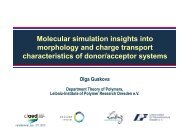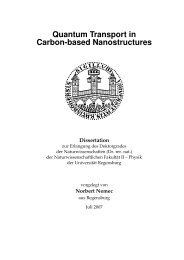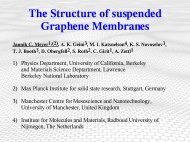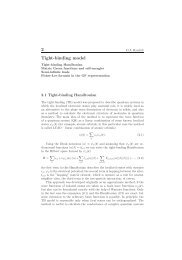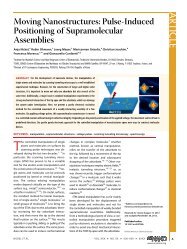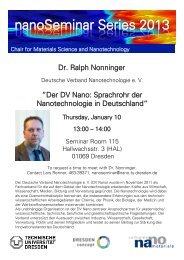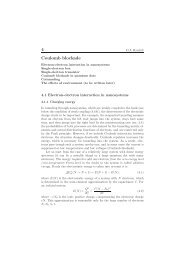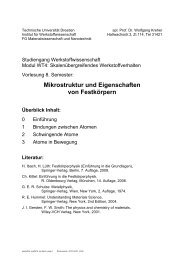Efficient linear scaling method for computing the thermal conductivity ...
Efficient linear scaling method for computing the thermal conductivity ...
Efficient linear scaling method for computing the thermal conductivity ...
You also want an ePaper? Increase the reach of your titles
YUMPU automatically turns print PDFs into web optimized ePapers that Google loves.
EFFICIENT LINEAR SCALING METHOD FOR COMPUTING ... PHYSICAL REVIEW B 83, 155416 (2011)<br />
κ (nW/K)<br />
40<br />
35<br />
30<br />
25<br />
20<br />
15<br />
10<br />
5<br />
pristine<br />
L=100 nm<br />
L=500 nm<br />
L=1 μm<br />
L=2 μm<br />
0<br />
0 100 200 300 400 500<br />
Temperature (K)<br />
FIG. 7. (Color online) Thermal conductance <strong>for</strong> <strong>the</strong> ZGNR (Nz =<br />
80, solid lines) and <strong>the</strong> AGNR (Na = 138, dashed lines) with edge<br />
disorder of 10% and various ribbon lengths.<br />
<strong>the</strong>rmal conductance of AGNRs to be smaller than that of <strong>the</strong><br />
ZGNRs <strong>for</strong> a fixed-edge disorder strength and ribbon length.<br />
Although <strong>the</strong> difference is found to be reduced as <strong>the</strong> ribbon<br />
width increases (not shown), coherent phonon propagation is<br />
still sensitive to <strong>the</strong> ribbon edge shape.<br />
C. Limits of <strong>the</strong> <strong>method</strong>ology<br />
The fact that <strong>the</strong> relaxation time and <strong>the</strong> mean free path<br />
diverge as ω → 0 introduces a physical limit to calculate <strong>the</strong><br />
mean free paths using real-time simulation techniques. There<strong>for</strong>e,<br />
<strong>the</strong>re always exists a nonzero frequency, below which<br />
<strong>the</strong> diffusion coefficient D(t) does not reach its maximum<br />
value within a given computation time, and this sets a lowest<br />
accessible frequency ωmin. The phonon wave-packet dynamics<br />
is originally determined by <strong>the</strong> time evolution operator U(t);<br />
however, <strong>the</strong> Chebyshev expansion of U(t) has a relatively<br />
large error <strong>for</strong> low frequencies (see Fig. 2). There<strong>for</strong>e, it is<br />
preferable to use U(t) in place of U(t) <strong>for</strong> <strong>the</strong> sake of accuracy.<br />
However, <strong>the</strong> evolution of low-frequency modes is slower<br />
with U(t), and ωmin increases within a given computation<br />
time, which creates a computational limit. The accuracy of<br />
<strong>the</strong> results with U(t) needs to be checked when <strong>the</strong> disorder<br />
in <strong>the</strong> system is relatively strong. In <strong>the</strong> case of very strong<br />
disorder, <strong>the</strong> approximation is less accurate, and one has to<br />
use <strong>the</strong> expansion of U(t) directly. Even though <strong>the</strong> time<br />
evolution based on <strong>the</strong> expansion of U(t) cannot give <strong>the</strong><br />
correct in<strong>for</strong>mation about very low frequency modes, features<br />
<strong>for</strong> <strong>the</strong> high-frequency modes can still be extracted, provided<br />
that <strong>the</strong> time step and <strong>the</strong> number of Chebyshev polynomials<br />
are chosen properly. The lowest accessible frequency by using<br />
* The first two authors contributed equally and share <strong>the</strong> first<br />
authorship of this work.<br />
† stephan.roche@icn.cat<br />
‡ g.cuniberti@tu-dresden.de<br />
1 C. W. Chang, D. Okawa, H. Garcia, T. D. Yuzvinsky, A. Majumdar,<br />
and A. Zettl, Appl. Phys. Lett. 90, 193114 (2007).<br />
155416-7<br />
U(t) can be smaller than <strong>the</strong> one from U(τ), depending on <strong>the</strong><br />
system. We also note that ωmin depends on <strong>the</strong> computational<br />
capability. Since one can upscale <strong>the</strong> calculations by means<br />
of high-per<strong>for</strong>mance <strong>computing</strong>, materials o<strong>the</strong>r than carbon<br />
are within reach of <strong>the</strong> presented scheme. It is also worth<br />
mentioning that, even without high-per<strong>for</strong>mance computation<br />
techniques, we could achieve mean free paths as long as a few<br />
micrometers, at <strong>the</strong> same order of magnitude with experimental<br />
sample sizes. At <strong>the</strong>se length scales, boundary scattering is <strong>the</strong><br />
detrimental scattering mechanism.<br />
For systems where anharmonicity plays an important role,<br />
an extension of <strong>the</strong> current <strong>method</strong>ology is required to account<br />
<strong>for</strong> dissipation effects and phonon lifetimes. The inclusion<br />
of anharmonic effects is beyond <strong>the</strong> scope of this study and<br />
deserves fur<strong>the</strong>r consideration.<br />
IV. CONCLUSION<br />
We have presented an efficient <strong>linear</strong> <strong>scaling</strong> approach to<br />
compute coherent phonon wave-packet propagation in real<br />
space and to evaluate <strong>the</strong> related <strong>the</strong>rmal conductance. The<br />
computational accuracy and efficiency were demonstrated <strong>for</strong><br />
isotope disordered carbon nanotubes and large-width graphene<br />
nanoribbons with edge disorder, respectively. A strong impact<br />
of edge-disorder profile on <strong>the</strong> <strong>the</strong>rmal conductance was found,<br />
as well as an edge shape dependence of <strong>the</strong>rmal conductance,<br />
opening interesting perspectives <strong>for</strong> <strong>the</strong>rmoelectrical applications.<br />
One should remark that this <strong>linear</strong> <strong>scaling</strong> <strong>method</strong> can<br />
be implemented without major difficulty <strong>for</strong> a wide range of<br />
o<strong>the</strong>r materials, including boron-nitride-based materials 55 or<br />
silicon-based materials (nanowires, superlattices, etc.). 56<br />
ACKNOWLEDGMENTS<br />
This work was supported by <strong>the</strong> priority program Nanostructured<br />
Thermoelectrics (SPP-1386) of <strong>the</strong> German Research<br />
Foundation (DFG Contract No. CU 44/11-1), <strong>the</strong> cluster<br />
of excellence of <strong>the</strong> Free State of Saxony ECEMP—European<br />
Center <strong>for</strong> Emerging Materials and Processes Dresden (Project<br />
No. A2), <strong>the</strong> European Social Funds in Saxony (research group<br />
InnovaSens), and <strong>the</strong> Alexander von Humboldt Foundation.<br />
This work is also supported by <strong>the</strong> NANOSIM-GRAPHENE<br />
Project No. ANR-09-NANO-016-01 funded by <strong>the</strong> French<br />
National Agency (ANR) in <strong>the</strong> frame of its 2009 program<br />
in Nanosciences, Nanotechnologies and Nanosystems<br />
(P3N2009) and by <strong>the</strong> World Class University program sponsored<br />
by <strong>the</strong> South Korean Ministry of Education, Science, and<br />
Technology Program, Project No. R31-2008-000-10100-0.<br />
The authors are thankful to N. Mingo <strong>for</strong> fruitful discussions.<br />
W.L. thanks <strong>the</strong> CAS-MPG joint doctoral promotion program.<br />
The Center <strong>for</strong> In<strong>for</strong>mation Services and High Per<strong>for</strong>mance<br />
Computing (ZIH) at TU-Dresden is acknowledged.<br />
2B. Li, L. Wang, and G. Casati, Appl. Phys. Lett. 88, 143501<br />
(2006).<br />
3L.-A. Wu and D. Segal, Phys. Rev. Lett. 102, 095503 (2009).<br />
4L. Wang and B. Li, Phys.Rev.Lett.99, 177208 (2007).<br />
5G. Pernot, M. Stoffel, I. Savic, F. Pezzoli, P. Chen, G. Savelli,<br />
A. Jacquot, J. Schumann, U. Denker, I. Mönch, Ch. Deneke, O. G.



